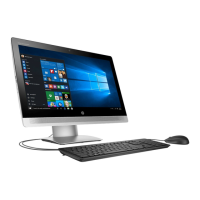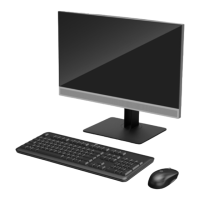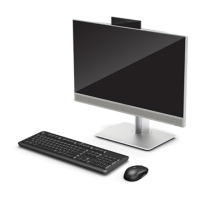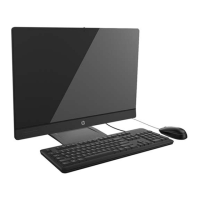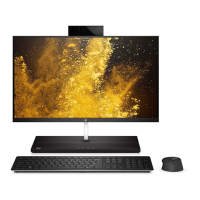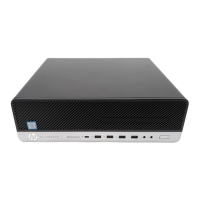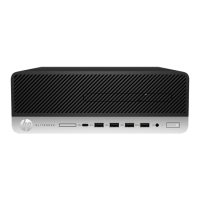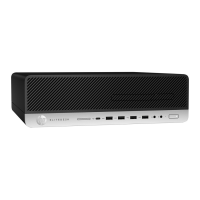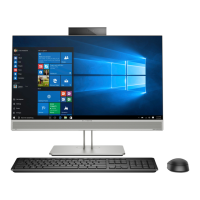
Do you have a question about the HP EliteOne G5 and is the answer not in the manual?
| Chipset | Intel Q370 |
|---|---|
| Memory | Up to 64GB DDR4 |
| Storage | Up to 2TB HDD or 1TB SSD |
| Graphics | Intel UHD Graphics 630 |
| Display | 23.8" |
| Audio | Bang & Olufsen |
| Networking | Bluetooth 5.0 |
| Ports | USB 3.1 |
| Operating System | Windows 10 Pro |
| CPU | Intel Core i5/i7 (9th Gen) |
Provides a general description of the product's features and functionality.
Details the components located on the front of the computer for various models.
Identifies and describes the components of the optional IR and FHD webcams.
Details the components located on the sides of the computer, including ports and sensors.
Details the various ports and connectors located on the rear of the computer.
Identifies the components located on the bottom of the computer, including ports and buttons.
Describes the features and components of the computer's keyboard.
Explains how to use the Radio Frequency Identification (RFID) reader for wireless information transfer.
Details the RFID Asset Tag feature, its purpose, and how to check for its presence.
Provides instructions on how to find the serial and product numbers on the computer.
Lists and illustrates the major computer components and their descriptions.
Illustrates and describes various plastic parts of the computer, varying by model.
Illustrates and describes the various circuit boards within the computer system.
Lists and describes the different types of mass storage devices available for the computer.
Details the available processors and memory modules with their specifications.
Lists and describes various internal and external cables and adapters for the computer.
Lists and describes the different keyboard and mouse options for the computer.
Provides initial safety procedures and steps required before disassembling the computer.
Detailed steps for removing the rear port cover from the computer chassis.
Instructions for removing the computer's recline and adjustable height stands.
Steps for removing the main rear access panel to access internal components.
Detailed instructions for removing and replacing the 2.5-inch primary hard drive.
Details on removing and installing memory modules, including specifications and locations.
Detailed instructions for removing and replacing the computer's processor.
Comprehensive steps for removing and replacing the main system board.
Instructions for removing and replacing the computer's display panel.
Explains ESD risks and precautions to protect components from static damage.
Provides guidelines for operating the computer and performing routine care and cleaning.
Key considerations for computer disassembly, including tools, parts, and procedures.
Explains the various tasks that can be performed using the Computer Setup (F10) Utility.
Provides steps on how to access and navigate the Computer Setup Utilities menu.
Details the options and settings available in the Main section of Computer Setup.
Details the options and settings available in the Security section of Computer Setup.
Details the options and settings available in the Advanced section of Computer Setup.
Instructions on how to restore computer configuration settings using the Computer Setup Utility.
Guide to using the Windows-based utility for running hardware diagnostic tests.
Instructions for downloading the HP PC Hardware Diagnostics Windows software.
Steps for installing the HP PC Hardware Diagnostics Windows software.
Guide to using the UEFI utility for running hardware diagnostic tests outside the OS.
Steps to troubleshoot common issues before contacting technical support.
Troubleshooting steps for common general computer problems.
Troubleshooting steps for common power-related issues.
Troubleshooting steps for common hard drive errors and issues.
Troubleshooting steps for common network connectivity issues.
Troubleshooting steps for common software-related issues.
Guide to backing up personal information and creating system recovery media.
Options for restoring, resetting, and refreshing the computer system.
Lists POST errors with numeric codes, text messages, probable causes, and recommended actions.
Explains how to interpret system validation error codes from LEDs and audible signals.
Instructions for clearing system passwords by resetting the password jumper.
Steps to reset BIOS settings to default values using the CMOS button.
Specifies general requirements for power cord sets applicable to all countries.
Specific requirements for using power cords in Japan.
Details power cord requirements specific to various countries.
Information on nonvolatile memory types, their purpose, and how data is stored and protected.
Frequently asked questions about BIOS, UEFI, and memory volatility.
Provides physical dimensions of the computer with and without stands.
Lists the approximate weight of the computer models.
Specifies the operating and non-operating temperature ranges for the computer.
Details the voltage range and line frequency for the computer's power supply.
States the maximum operating power consumption for UMA and Discrete models.
